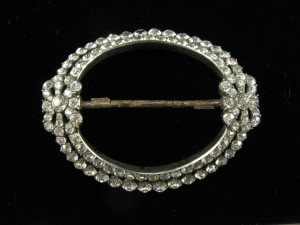I love fine paste jewelry from all eras but Georgian paste is the finest ever produced.
Paste is glass that is meant to look like gemstones and in my Ruby Lane shop I have pieces dating from the Georgian era through the mid-20th century. When I refer to “paste”, as opposed to rhinestone, jewelry I distinguish it by the quality of its construction: paste jewelry is constructed just like fine jewelry using glass stones instead of gemstones in settings of gold or silver. However, not everyone uses the term in this manner; some people throw around the terms “paste” and “rhinestone” interchangeably.

Georgian paste was hand-faceted and made of high-lead-content glass. The stones usually have collet (also known as bezel) settings. Often these collets are crimped at the edges and sometimes cut back to give the illusion of prongs. These setting are sometimes referred to as “crimped collet settings” or “cut-down collet settings”. Colorless stones were usually set in silver. While technically not glass, rock crystal was sometimes used in jewelry that visually is identical to paste jewelry, and it is acceptable to lump these two materials together; in fact I have had several pieces of jewelry that used both rock crystal and paste in the same item.

Most often these setting have closed backs which had reflective foil behind the stone made of silver or silvered copper. Sometimes the foils were hand-tinted to make the stones look colored.

Georgian paste often has a black dot painted on the bottom of the culet, the pointy part at the bottom of the stone, so you will see the term “black dot paste” sometimes used to describe early paste jewelry. This black dot helped give the illusion of depth in the stone.
Quite a lot of Georgian paste jewelry that is on the market today started out as men’s jewelry. In the 19th century – when men stopped wearing jeweled buttons, cuff links, buckles on their breeches, and shoe buckles – some pieces of men’s jewelry were transformed into pieces of jewelry for women, so it’s not uncommon to find antique “C” clasp pin backs, old styles of ring shanks, or other antique fittings added to pieces of early paste.
With a renewed appreciation for Georgian paste a lot of conversions of buttons and cufflinks to earrings are currently taking place. These solitaire earrings are a recent conversion.


This ring is a conversion of what was probably a Georgian paste fob into a beautiful women’s ring; the conversion probably took place during the Victorian era or early 20th century. It also demonstrates another characteristic of Georgian paste: unusually-shaped stones. Because glass is much easier to cut than gemstones, and inexpensive to replace if a mistake is made in cutting, jewelers were free to cut stones in unusual shapes that would have been difficult to achieve with gemstones. This allowed paste to become an art form of its own and not simply a cheap substitute for gemstones.
On the ring shown above the silver used for the collet settings is so fine that it is barely visible and air-tight. Because of these air-tight settings, if not damaged by wear or submerged in water, the reflective foils behind Georgian paste stones can survive for hundreds of years with little tarnish and the jewelry can be as beautiful and wearable today as when it was new.
There are three books that I highly recommend if you are interested in learning more about Georgian paste jewelry (note: all books are British, hence the British spelling of “jewellery” instead of “jewelry” in all these titles): Georgian Jewellery by Ginny Reddington Dawes and Olivia Collings which is the “bible” of Georgian jewelry and readily available; Antique Paste Jewellery by M.D.S Lewis which is the best book about paste jewelry but is out of print (but is sometimes available on Amazon through associate sellers); and Brilliant Impressions, an Exhibition of Antique Paste and Other Jewellery by Diana Scarisbrick which is available by special order and has the best photos of Georgian paste jewelry.
ShareFollow

I have a Georgian paste bracelet and I submerged it to clean it and when I came back there were lots of little pieces of silver paper floating on the water, what can I do, can they be replaced, thanks KP
Hi Katen,
I’m assuming you have closed-back stones and that what you’re seeing is silver “foil” that came out when your piece was soaked. That makes me wonder if your piece is genuine Georgian, or a Georgian revival piece. I’ve had a few broken pieces and the foils that I’ve seen have been made of metal. Also, Georgian collet settings on the stones are tight around the stone and wouldn’t allow a foil, or foiled paper in your case, to escape.
Of course it’s hard to tell without seeing a piece, but from your description it sounds like you have a later piece made with unusual construction.
Lisa
Very informative, I had no idea what paste really meant. I thought it was an old fashioned term for rhinestone.